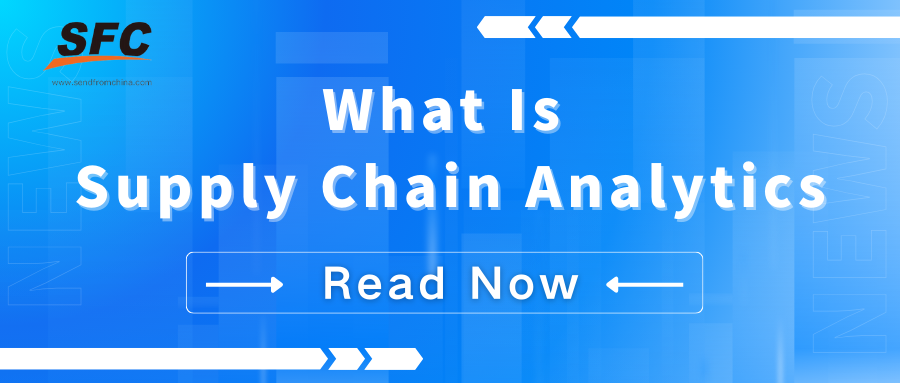Table of Contents
What Is Supply Chain Analytics? Definition & How-to
Time: Feb 06,2025 Author: SFC Source: www.sendfromchina.com
As businesses face increasing pressure to deliver goods quickly and cost-effectively, supply chain analytics has become a critical tool for success. By transforming data into actionable insights, companies can reduce waste, anticipate demand, and address operational challenges head-on. Dive into our blog to explore everything from core analytics types to real-world implementations that drive results.
1. Understanding Supply Chain Analytics
Supply chain analytics involves the process of collecting, analyzing, and interpreting data from various stages of the supply chain to enhance decision-making, operational efficiency, and overall performance. By leveraging data, businesses can identify bottlenecks, predict demand fluctuations, reduce costs, and improve customer satisfaction.Supply chain analytics aims to create a more agile, adaptive, and resilient supply chain capable of navigating disruptions, fulfilling market demands, and optimizing resources.
2. Why Supply Chain Analytics Matters for Ecommerce
In the fast-paced world of ecommerce, supply chain efficiency directly impacts customer experience, brand reputation, and profitability. Supply chain analytics empowers ecommerce businesses to optimize delivery timelines, reduce inventory holding costs, and predict future demand accurately.As customers expect rapid deliveries and real-time tracking, businesses leveraging data-driven insights can improve logistics coordination, minimize shipping delays, and maintain stock availability. In competitive markets, companies that utilize supply chain analytics gain a significant advantage by anticipating challenges before they arise.
Key benefits include:
- Demand Forecasting: Predict trends and ensure adequate inventory levels.- Cost Optimization: Identify areas to reduce operational expenses.
- Customer Satisfaction: Meet delivery promises and avoid stockouts.
3. Key Types of Supply Chain Analytics

Descriptive Analytics
Descriptive analytics focuses on providing an overview of what has happened within the supply chain. By analyzing historical data, businesses gain insights into past performance, identifying trends and anomalies.Common Use Cases:
- Tracking on-time delivery rates.
- Monitoring warehouse efficiency.
- Identifying past bottlenecks.
Predictive Analytics
Predictive analytics uses machine learning, statistical models, and historical data to forecast future outcomes. It answers questions like "What is likely to happen?" and allows companies to prepare for various scenarios.Common Use Cases:
- Forecasting demand during peak seasons.
- Predicting supplier delays.
- Anticipating inventory shortages.
Prescriptive Analytics
Prescriptive analytics goes beyond predictions and provides actionable recommendations. It helps businesses decide the best course of action by analyzing possible outcomes.Common Use Cases:
- Optimizing delivery routes.
- Determining reorder points.
- Suggesting alternative suppliers during disruptions.
Diagnostic Analytics
Diagnostic analytics digs into the reasons behind past outcomes. By identifying the root causes of issues, businesses can prevent similar problems from occurring in the future.Common Use Cases:
- Investigating missed delivery deadlines.
- Analyzing quality control failures.
- Understanding inventory discrepancies.
4. Real-World Applications of Supply Chain Analytics

Amazon: Mastering Inventory and Delivery Optimization
Amazon’s success is largely due to its ability to predict customer demand and ensure products are available and delivered on time. By analyzing millions of data points, the company optimizes everything from warehouse stocking to delivery routes.Procter & Gamble: Demand-Driven Supply Chain
P&G uses predictive analytics to anticipate fluctuations in demand and adjust production accordingly. It enables them to prevent shortages during peak seasons and avoid excess inventory during slow periods.Walmart: Supplier Collaboration
Walmart employs real-time data sharing and analytics with suppliers, helping them maintain low inventory levels while ensuring shelves are always stocked. The collaboration also improves vendor performance and strengthens the supply chain.5. How Companies Implement Supply Chain Analytics

Data Integration and Collection
Data is the backbone of any analytics initiative. Companies must first integrate data from various sources, including suppliers, warehouses, transportation providers, and customer interactions.Key Steps:
- Consolidate data from ERP, CRM, and WMS systems.
- Ensure data accuracy and completeness.
- Regularly update datasets to reflect real-time conditions.
Choosing the Right Tools
Selecting the right analytics software is critical for extracting actionable insights. Tools like Tableau, Power BI, and custom-built analytics platforms offer data visualization and predictive modeling capabilities.Factors to Consider:
- Scalability to handle large datasets.
- Integration capabilities with existing systems.
- User-friendly dashboards for non-technical staff.
Employee Training and Change Management
For successful implementation, employees must understand how to use analytics tools and interpret results. Change management programs ensure a smooth transition and encourage adoption.Strategies:
- Conduct regular training sessions.
- Offer hands-on experience with analytics software.
- Create a culture of data-driven decision-making.
6. Challenges in Implementing Supply Chain Analytics
While the benefits are clear, implementing supply chain analytics is not without challenges.Data Silos and Integration Issues
Many companies struggle with fragmented data stored across different systems. Without proper integration, analytics efforts can be incomplete or misleading.Solutions:
- Invest in data integration platforms.
- Implement centralized data repositories.
Lack of Skilled Talent
Data scientists, analysts, and supply chain professionals with analytics expertise are in high demand but short supply.Solutions:
- Provide in-house training.
- Collaborate with external consultants.
Scalability Concerns
As businesses grow, the volume of data increases exponentially. Ensuring analytics systems can scale accordingly is crucial.Solutions:
- Use cloud-based platforms.
- Regularly upgrade hardware and software resources.
7. Best Practices for Effective Supply Chain Analytics
To achieve maximum ROI, businesses should follow these best practices:- Start Small: Begin with pilot projects to test analytics strategies before scaling up.
- Define Clear KPIs: Establish metrics to measure the impact of analytics initiatives.
- Continuous Improvement: Regularly review analytics processes and refine strategies.
- Collaborate Across Teams: Encourage cross-departmental collaboration to share insights.
- Leverage Automation: Use AI and machine learning to automate data collection and analysis.
8. Conclusion
Supply chain analytics is a game-changer for businesses seeking to optimize operations, enhance customer satisfaction, and maintain a competitive edge. By adopting the right tools, overcoming challenges, and following best practices, companies can harness the full potential of data-driven decision-making. From predicting demand to mitigating disruptions, supply chain analytics is essential for navigating today’s complex business landscape.9. FAQs
1. What is supply chain analytics, and why is it important?
Supply chain analytics involves the use of data and analytics to optimize supply chain processes, improve efficiency, and make data-driven decisions. It is crucial for reducing costs, enhancing customer satisfaction, and managing risks.2. What are the different types of supply chain analytics?
The key types include descriptive analytics, predictive analytics, prescriptive analytics, and diagnostic analytics. Each type serves a distinct purpose, from understanding past events to recommending future actions.3. How do businesses collect data for supply chain analytics?
Data is collected from various sources, including ERP systems, CRM platforms, IoT devices, and external partners. Proper data integration ensures comprehensive insights.4. What are common challenges in implementing supply chain analytics?
Common challenges include data silos, lack of skilled professionals, and scalability concerns. Companies can address these by investing in integration tools, training staff, and using cloud-based platforms.5. How can supply chain analytics improve ecommerce operations?
Supply chain analytics helps ecommerce businesses forecast demand, optimize inventory, improve logistics efficiency, and enhance customer experience by reducing delays and stockouts. Post Views:5
Post Views:5
Copyright statement: The copyright of this article belongs to the original author. Please indicate the source for reprinting.
Previous Post
Next Post
What Are the Potential Risks in Third-Party Logistics (3PL) Partnership
TAGS
Hot Research
Get a Custom China Fulfillment Solution with FREE Storage for 30 Days
 Want to know about our services, fees or receive a custom quote?
Want to know about our services, fees or receive a custom quote?
 Please fill out the form on the right and we will get back to you within a business day.
Please fill out the form on the right and we will get back to you within a business day.
 The more information you provide, the better our initial response
will be.
The more information you provide, the better our initial response
will be.





 TAGS:
TAGS: